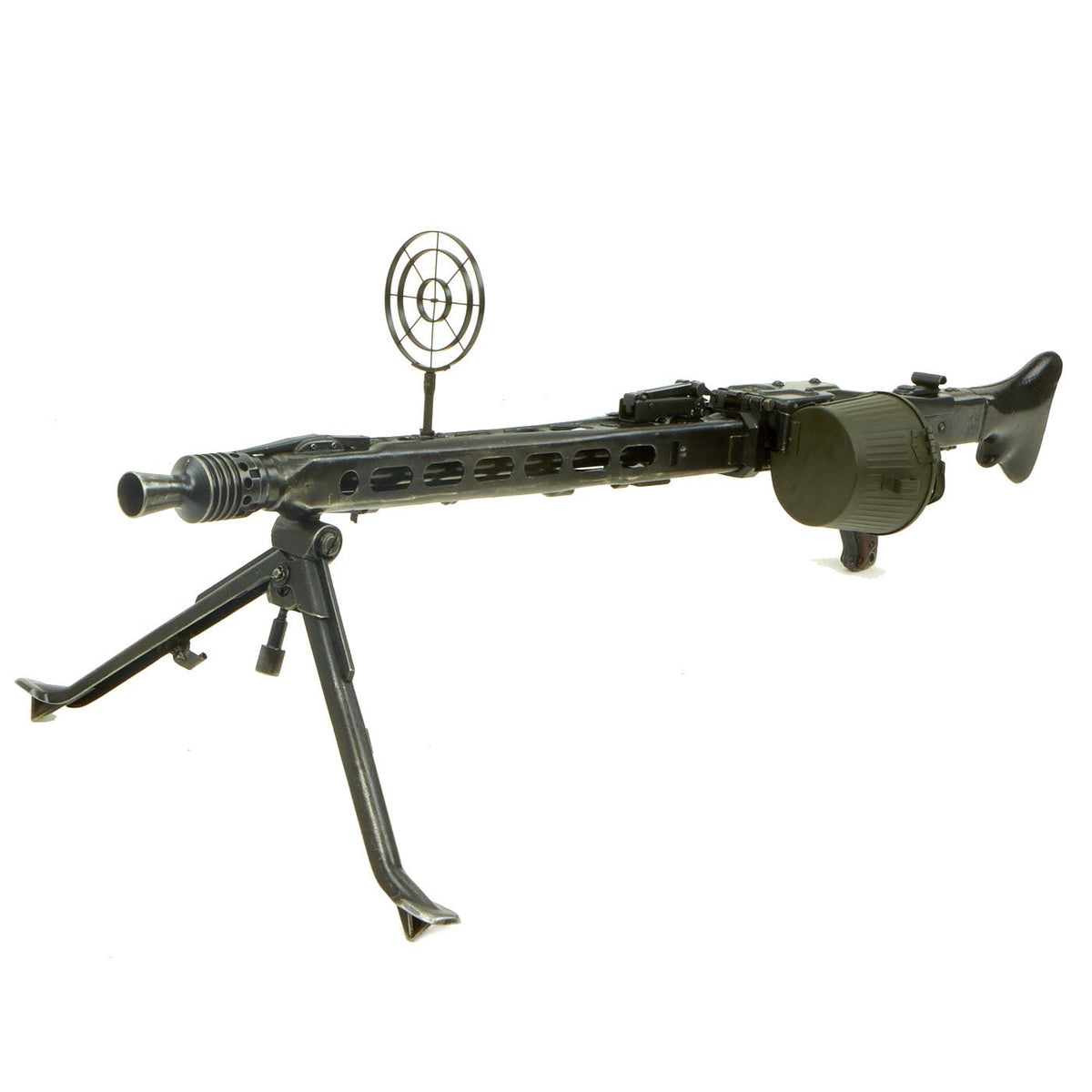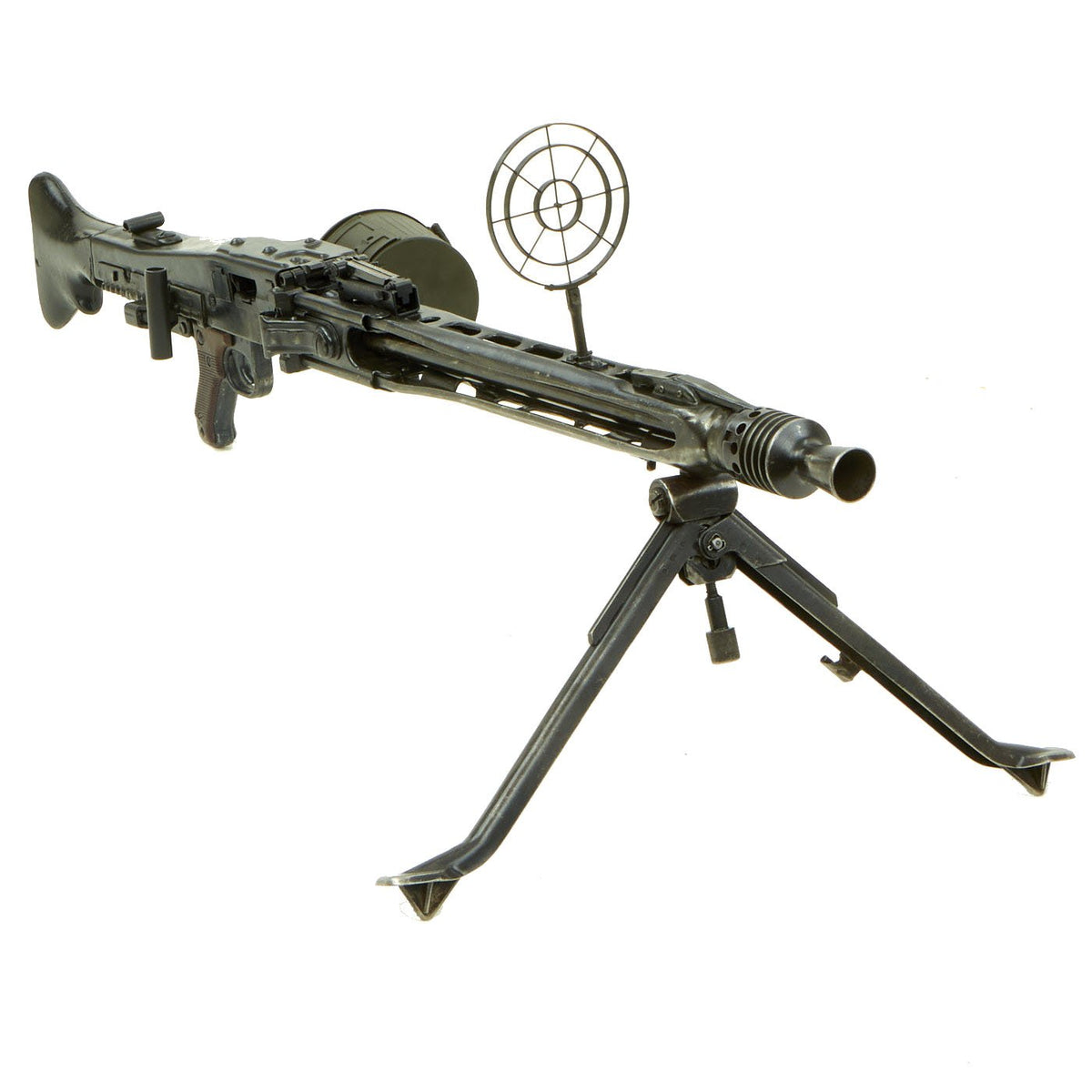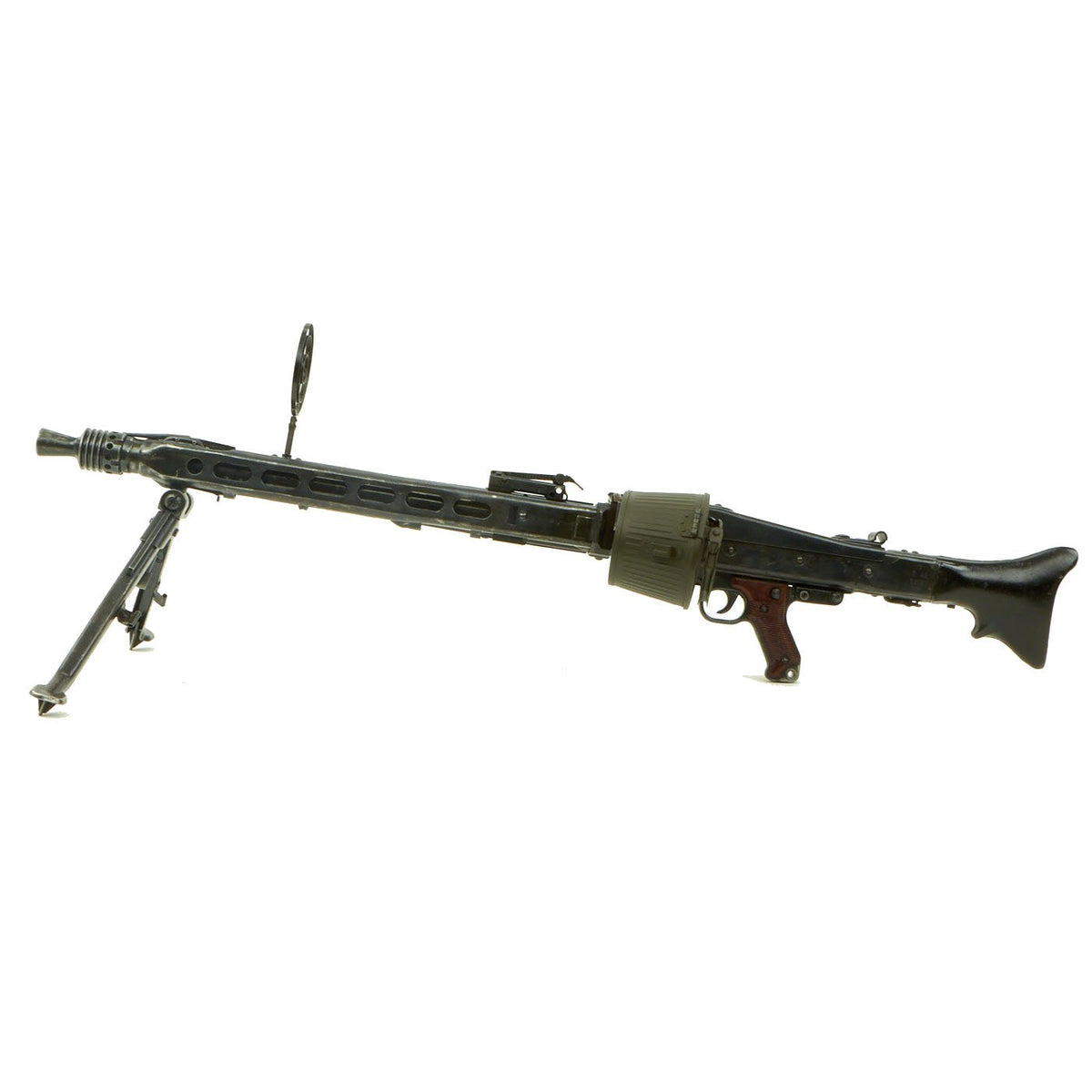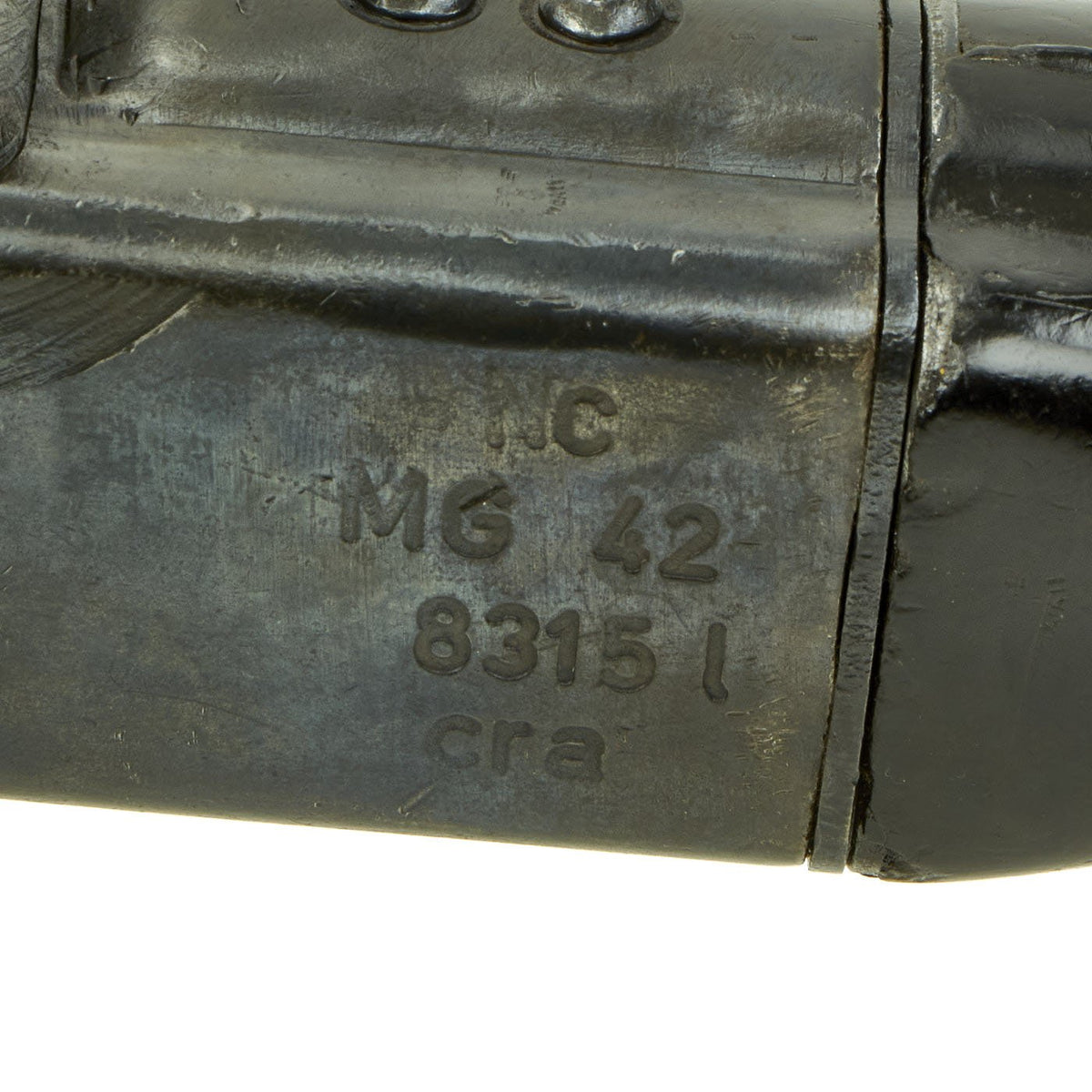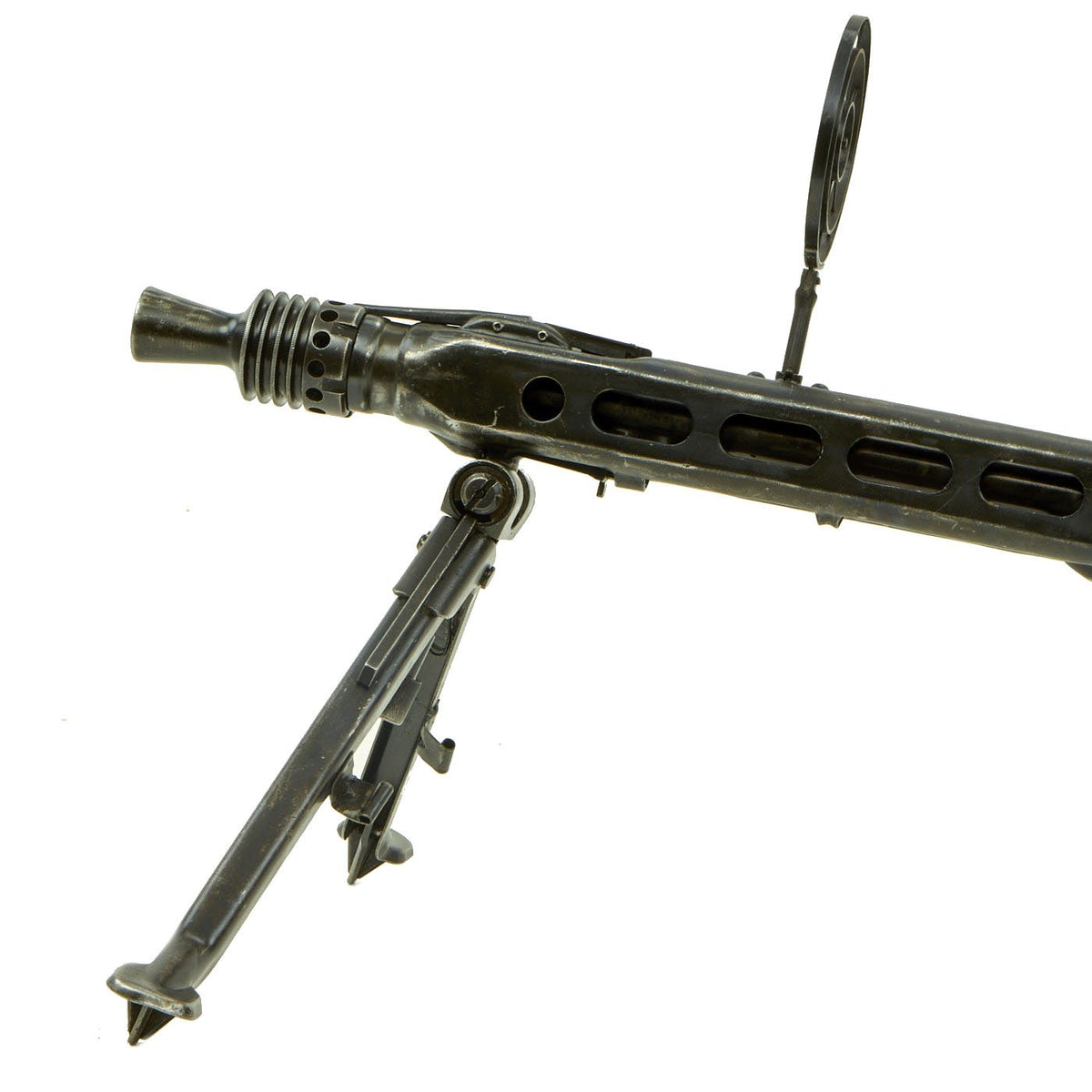Original German WWII 1944 made MG 42 Display Machine Gun by MAGET with Bakelite Butt Stock & Accessories Original Items
$ 5.995,00 $ 1.498,75
Original Item: Only One Available. Constructed from a legally demilitarized (de-milled) parts set, this is a wonderful and rare German WWII MG42 Display Gun.
Comprised mostly of original WWII parts, this display gun was reconstructed using a BATF approved receiver with 2 inches totally replaced with solid bar stock, making this an inert non-firing display gun. Comes complete with German WWII issue parts including a rare and desirable bakelite butt-stock, post-war painted drum belt carrier (missing slot cover), front Anti-Aircraft Spider Sight, and WWII Issue bipod.
The rebuilt inert non-firing BATF approved receiver with a solid steel new made section has fine markings that are easily visible and read-
NC
MG 42
8315 l
cra
cra is the maker code for MAGET – Maschinen und Geraetetbau GmbH, in Berlin-Tegel. This company was previously known as ALKETT-Altmärkische Kettenweke GmbH, Werk II, but was was renamed in 1942-1943. Starting in 1943, they switched to two letter codes for dates, with “NC” being the code for 1944. They later changed their maker code to “swd” for 1945 only, keeping the same “NC” date code. They made MG34 and MG42 machine guns, and also made components for armored vehicles.
There are multiple German Waffenamt proofs are various parts of the display gun, such as the top cover, receiver, sight, and others. There is even a maker marking ar on the “camming block” by the barrel change door, for the legendary Mauser-Werke AG, Werk Borsigwalde. The bipod is the correct type and is in great shape. The butt stock is a rare bakelite example, and is unmarked as far as we can see. This display gun bears additional markings on various components.
Offered in excellent condition this is a very hard to find all German WWII mg42 Display Machine Gun. We only get these a few times a year, if we are lucky, so act quickly as they never last long.
Note: as these were in service post war, some components may display Yugoslav stock markings in addition to German wartime markings.
The MG 42 (shortened from German: Maschinengewehr 42, or “machine gun 42”) is a 7.92×57mm Mauser general purpose machine gun designed in NSDAP Germany and used extensively by the Wehrmacht and the Waffen-SS during the second half of World War II. It was intended to replace the earlier MG 34, which was more expensive and took much longer to produce, but in the event, both weapons were produced until the end of the war.
The MG 42 has a proven record of reliability, durability, simplicity, and ease of operation, but is most notable for its ability to produce a high volume of suppressive fire. The MG 42 had one of the highest average cyclic rates of any single-barreled man-portable machine gun: between 1,200 and 1,500 rpm, resulting in a distinctive muzzle report. The only Allied automatic ordnance of any type with a similar calibre that was designed to exceed this rate of fire was the Soviet Union’s .30-calibre ShKAS machine gun for aircraft armament, due to its “squirrel-cage” layout, ten-round “pre-feed” mechanism giving it a firing rate of 1,800 rounds per minute.
One of the weapon’s most notable features was in its exceptionally high rate of fire of about 1,200 rounds per minute, twice the rate of the Vickers and Browning machine guns, which fired at a rate of about 600 rounds per minute. So effective was the weapon in laying suppressive fire that the United States Army created training films to aid its soldiers in dealing with the psychological trauma of facing the weapon in battle. The MG 42 fired at such a high rate the human ear could not easily discern the sound of individual shots being fired, instead hearing a sound described as like “ripping cloth” or a buzzsaw, giving rise to the nickname “AH’s buzzsaw” (and the German soldiers’ AHsäge (“AH’s saw” or “bonesaw”).
The gun was sometimes called “Spandau” by British troops, as was the MG 34, a traditional generic term for all German machine guns, left over from the famous Allied nickname for the MG 08 Maxim-derivative used by German forces during WWI, which was derived from its manufacturer’s plates noting the city where some were produced.[citation needed]
The MG 42’s high rate of fire resulted from analysis concluding that since a soldier typically only has a short period of time to shoot at an enemy soldier, and muzzle rise quickly throws off initial aim, it was imperative to fire the highest number of bullets possible in the shortest time to increase the likelihood of a hit before the recoil overcame the inertia of the gun and pushed the aiming point upwards. The disadvantage was that the weapon consumed exorbitant amounts of ammunition and quickly overheated its barrel, making sustained fire problematic. Thus, while individual bursts left the weapon as highly concentrated fire at 1,200 rounds per minute, the Handbook of the German Army (1940) forbade the firing of more than 250 rounds in a single burst and indicated a sustained rate of no more than 300-350 rounds per minute to minimize barrel wear and overheating, although the excellent quick-change barrel design helped a great deal. Burst limits are typical on non-water-cooled automatic weapons, and slower-firing Allied guns such as the M1919 also had limits; they fired at a slower rate, but lacked a quick-change barrel, and so the operator had to limit his fire to a few hundred rounds per minute to allow the barrel to cool between bursts. Due to the slower firing rate, this led to a longer period of time spent shooting, but a roughly equivalent total number of rounds fired. Operationally, the MG 42’s main drawback was that it could consume ammunition at such a high rate that it was very difficult to keep firing during offensive actions, because ammunition had to be carried forward on a continuous basis. This was also a problem at the end of the war with inexperienced German troops. Good fire discipline was necessary, and the level of training that the German infantry was receiving at that time was poor.
The method of barrel change made the MG 42 unsuitable for secondary or co-axial armament on World War II era German tanks with the exception of the Jagdpanzer IV. Early versions of the Jagdpanzer IV carried two standard (no modification made) MG 42s on both sides of the gun mantlet/glacis, firing through a ball slot which was protected by an armored cover (with the MG 42 retracted) when not in use. Later version Jagdpanzer IVs carried only one MG 42 on the left side.
In the German heavy machine gun (HMG) platoons, each platoon served four MG 34/MG 42 machine guns, used in the sustained fire mode mounted on tripods. In 1944 this was altered to six machine guns in three sections with two seven-man heavy machine gun squads per section as follows:
Squad leader (NCO) MP40
Machine gunner (private) MG 34/MG 42 and pistol
Assistant gunner (private) pistol
Three riflemen (privates) rifles
Horse leader for horse, cart and trailer (private) rifle
The MG-42 incorporated lessons hard-won on the Eastern Front. Both the cocking handle and the catch for the top cover to the working parts were designed so that the gunner could operate them wearing mitts or with a stick or rod. This was vital for winter conditions where contact by bare flesh on cold metal could cause severe injury, such as instant frostbite.
The MG42’s effect was so devastating that Allied troops were trained before the D Day landings to distinguish its unique sound when fired, which was like cloth being ripped or the sound of a buzzsaw. Allied troops were trained to charge an MG-42-equipped pill box only at the time of its one weakness, which was when its overheating barrel needed to be changed.
Fast Shipping with Professional Packaging
Thanks to our longstanding association with UPS FedEx DHL, and other major international carriers, we are able to provide a range of shipping options. Our warehouse staff is expertly trained and will wrap your products according to our exact and precise specifications. Prior to shipping, your goods will be thoroughly examined and securely secured. We ship to thousands clients each day across multiple countries. This shows how we're dedicated to be the largest retailer on the internet. Warehouses and distribution centres can be located throughout Europe as well as the USA.
Note: Orders with more than one item will be assigned a processing date depending on the item.
Before shipping before shipping, we'll conduct a thorough inspection of the items you have ordered. Today, the majority of orders will be delivered within 48 hours. The delivery time will be between 3-7 days.
Returns
The stock is dynamic and we cannot completely manage it because multiple stakeholders are involved, including our factory and warehouse. So the actual stock may alter at any time. It's possible that you may not receive your order once the order has been made.
Our policy is valid for a period of 30 days. If you don't receive the product within 30 days, we are not able to issue a refund or an exchange.
You can only return an item if it is unused and in the same state as the day you received it. You must have the item in its original packaging.
Related products
Uncategorized
Uncategorized
Uncategorized
Armored Burgonet Helmet & Polearm from Scottish Castle Leith Hall Circa 1700 Original Items
Uncategorized
Uncategorized
Uncategorized
Uncategorized
Uncategorized
Uncategorized
Uncategorized
Uncategorized
Uncategorized
Uncategorized
Australian WWII Owen MK1 Machine Carbine SMG Custom Fabricated Replica with Sling Original Items
Uncategorized
Uncategorized
Uncategorized
Uncategorized
Uncategorized
Uncategorized
